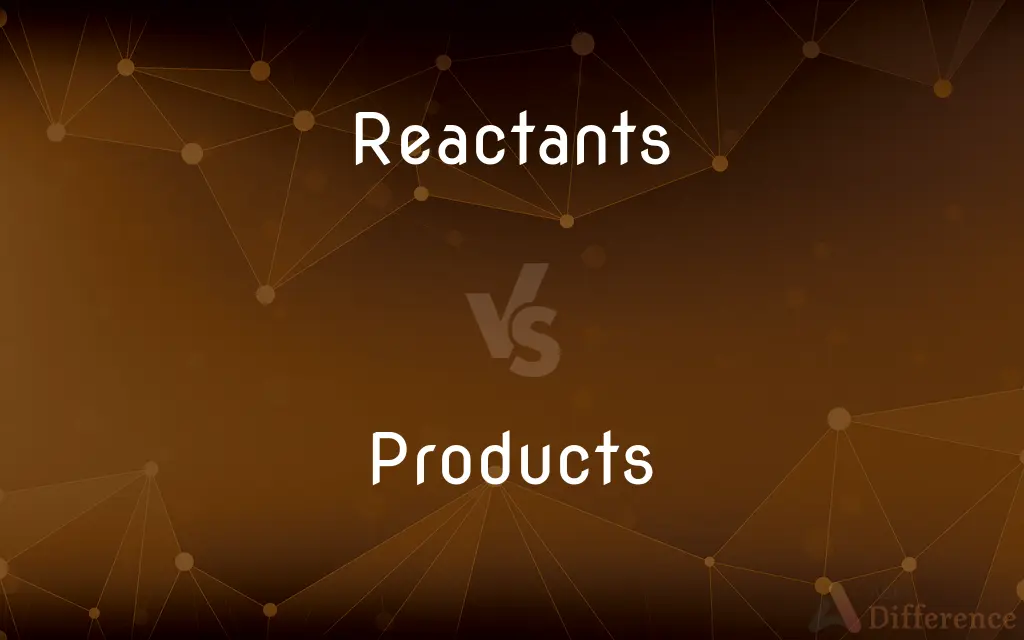Reactants vs. Products — What's the Difference?
By Tayyaba Rehman — Published on November 27, 2023
Reactants are substances initially present in a chemical reaction, while Products are substances formed as a result of the reaction.

Difference Between Reactants and Products
Table of Contents
ADVERTISEMENT
Key Differences
The intriguing realm of chemistry vividly showcases a dynamic interplay between reactants and products during chemical reactions. In this scientific theater, reactants take the limelight as the initial substances, those that undergo change, actively participating in the chemical reaction. Products, conversely, gracefully emerge through the curtain of transformation, appearing as the substances formed post-reaction, eloquently depicting the consequential aspect of the metamorphosis from reactants to products.
Through a chemical journey, one witnesses the transformation of reactants into products, observing matter assuming new forms and identities. Reactants, possessing distinct properties and compositions, engage in chemical interactions, surrendering to the transformative process of the reaction. Emerging from this transformative cascade, products manifest, bearing new properties, and compositions, offering a tangible representation of the chemical alterations initiated by the reactants, signifying the perpetual dance between reactants and products.
As the curtains of chemical equations are drawn, they reveal symbols and coefficients illustrating the stoichiometric relationships between reactants and products. Reactants, typically placed on the left side of the chemical equation, are denoted with specific coefficients indicating the molar ratios involved in the reaction. On the flip side, products emerge on the right, substantiating the stoichiometric outcome of the reaction, further solidifying the systematic connection between reactants and products in chemical representations.
Chemical kinetics delves into the velocity of reactions, scrutinizing the rate at which reactants transform into products. In this kinetic panorama, reactants typically decrease in concentration over time as they morph into products, showcasing a decline in their presence within the reaction medium. Concurrently, products progressively accumulate, their concentration ascending as the reaction unfolds, painting a temporal portrait of the systematic transition from reactants to products.
Reactants and products collaboratively narrate the tale of chemical reactions, embodying the inception and culmination of material change, respectively. Reactants, surrendering their initial state, catalyze the chemical narrative, propelling matter into new formations. Products, symbolic of chemical evolution, chronicle the conclusion of the reaction, embodying the transformed state of the initial reactants and representing the final chapter in the narrative arc stretching from reactants to products.
ADVERTISEMENT
Comparison Chart
Position in Reaction
Present initially
Formed during the reaction
Chemical Equation Side
Left side
Right side
Concentration Change
Decreases during reaction
Increases during reaction
Role in Reaction
Undergo change
Result from change
Stoichiometric Coefficient
Indicate starting molar quantities
Indicate resulting molar quantities
Compare with Definitions
Reactants
Chemical Change Undergoers
In the reaction, the reactants lost electrons and formed new bonds.
Products
Matter Formed Post-Reaction
New substances, known as products, were analyzed using chromatography.
Reactants
Reaction Starters
To initiate the reaction, reactants were mixed in a beaker.
Products
Chemical Change Outcomes
The products displayed distinct properties compared to the initial substances.
Reactants
Matter Subject to Alteration
The reactants underwent a physical change upon heating.
Products
Resultant Substances
Water and carbon dioxide were the products of combustion.
Reactants
Participants in Chemical Equations
In the equation, the reactants were denoted with their respective coefficients.
Products
An item that is made or refined and marketed
Farm products.
Soaps, detergents, and similar products.
Travel products such as vacation trips.
Reactants
Initial Substances
The reactants, hydrogen and oxygen, were stored in separate containers.
Products
Such items considered as a group
Sold a lot of product in May.
Reactants
A substance that is altered or incorporated into another substance in a chemical reaction, especially a directly reacting substance present at the initiation of the reaction.
Products
A preparation, such as a gel, used for styling hair
Began to use product soon after he became famous.
Reactants
Plural of reactant
Products
A substance resulting from a chemical or nuclear reaction.
Products
A direct result; a consequence
"Is history the product of impersonal social and economic forces?" (Anthony Lewis).
Products
A person whose characteristics or abilities are the result of certain influences or kinds of experience
"She is the product of an America in which explicit displays of pride in intellect are considered unseemly" (Yuval Levin).
Products
The number or quantity obtained by multiplying two or more numbers together.
Products
A scalar product.
Products
A vector product.
Products
Plural of product
Products
Reaction End
The experiment concluded with the isolation of products.
Products
Concluding Elements in Equations
In the chemical equation, products were denoted on the right side.
Common Curiosities
Do reactants always completely convert into products?
Not always, reactions may not go to completion, leaving residual reactants.
What are reactants in a chemical reaction?
Reactants are the initial substances that undergo change in a chemical reaction.
Can products revert back to reactants?
Yes, in reversible reactions, products can convert back into reactants.
What defines products in a chemical reaction?
Products are the substances formed as a result of a chemical reaction.
How are the quantities of reactants and products related?
Quantities are related through stoichiometric coefficients in balanced chemical equations.
Can the number of reactants and products be different?
Yes, reactions can have different numbers of reactant and product molecules.
How are reactants and products represented in a chemical equation?
Reactants are written on the left, and products are written on the right side of the arrow in a chemical equation.
Can reactants be isolated from products post-reaction?
Yes, through various separation techniques, reactants can often be isolated from products.
How does a catalyst impact reactants and products?
A catalyst speeds up a reaction, facilitating the transformation of reactants to products without being consumed.
How do reactants contribute to reaction energy profiles?
Reactants’ energies influence activation energy and the overall energy change in a reaction.
Are the physical states of reactants and products always the same?
No, reactants and products can exist in different physical states (solid, liquid, gas).
Can a substance be both a reactant and a product?
In certain reversible reactions, a substance can indeed be both a reactant and a product.
How does temperature affect reactants and products?
Temperature can influence the rate and direction of a reaction, affecting reactants' conversion to products.
Can a single reactant form multiple products?
Yes, a single reactant can engage in pathways leading to the formation of multiple products.
Are products always stable?
Not necessarily, products’ stability can vary and some may further react or decompose.
Share Your Discovery

Previous Comparison
Forename vs. First Name
Next Comparison
UN vs. UNOAuthor Spotlight
Written by
Tayyaba RehmanTayyaba Rehman is a distinguished writer, currently serving as a primary contributor to askdifference.com. As a researcher in semantics and etymology, Tayyaba's passion for the complexity of languages and their distinctions has found a perfect home on the platform. Tayyaba delves into the intricacies of language, distinguishing between commonly confused words and phrases, thereby providing clarity for readers worldwide.














































